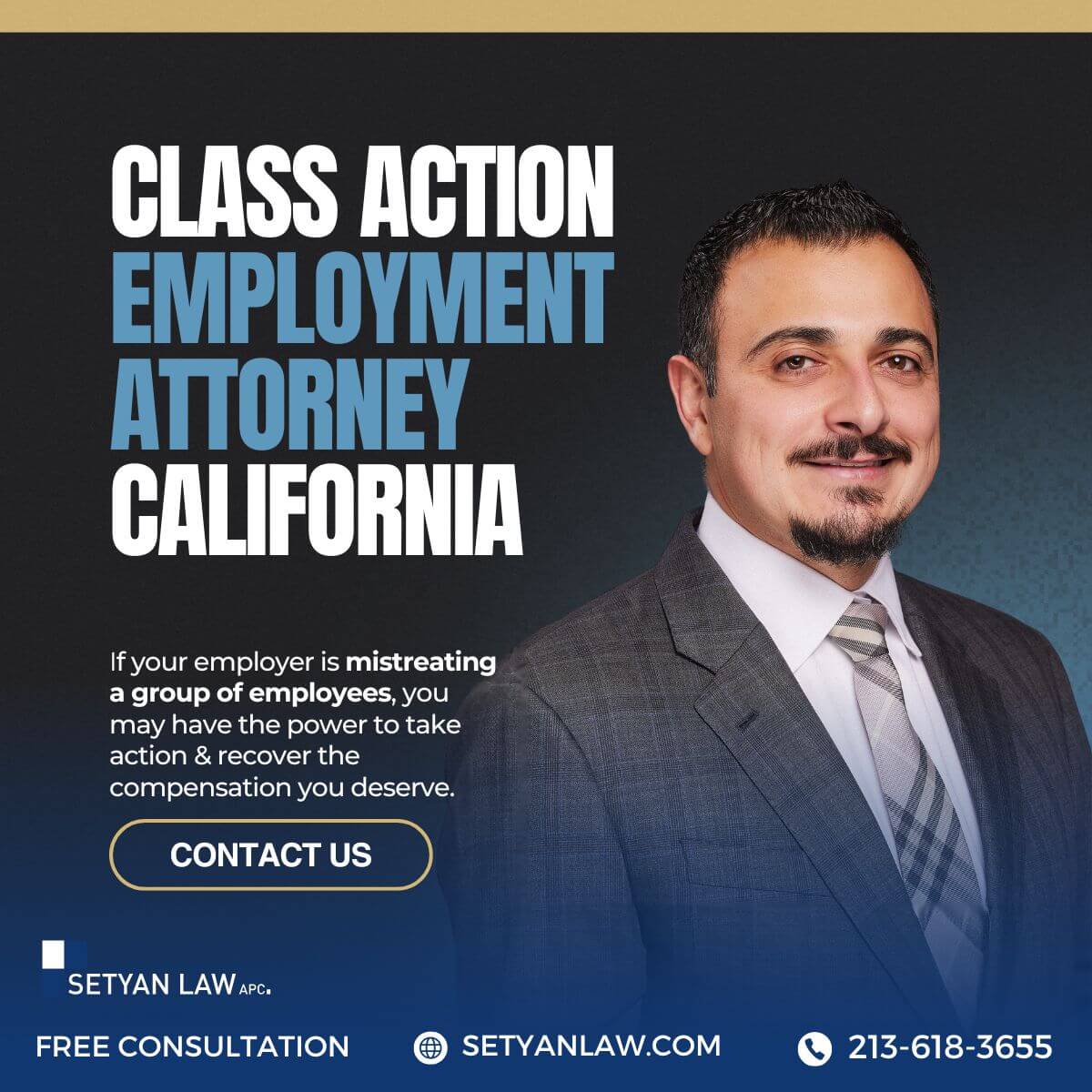Updated October 31, 2025
How to Initiate an Employment Class Action Lawsuit: A Comprehensive Guide
When multiple employees face similar workplace injustices, a class action lawsuit can be a powerful legal remedy. This collective approach allows workers to combine their grievances into a single case, creating strength in numbers against employers who may have violated California law or federal regulations. If you believe your workplace rights have been compromised alongside those of your colleagues, understanding the process of initiating a class action lawsuit is crucial.
Workplace violations affecting numerous employees simultaneously—whether involving wage theft, discrimination, or unsafe conditions—often warrant class action consideration. This legal pathway not only makes justice more accessible but also creates meaningful accountability for employers who might otherwise escape consequences for widespread misconduct.
The decision to pursue a class action lawsuit requires careful consideration of various factors, including the nature of the violations, the number of affected employees, and the potential for meaningful resolution. By understanding the fundamentals of class action litigation, you can make informed decisions about protecting your rights and those of your coworkers.
Class action lawsuits serve an important function in our legal system by allowing groups of similarly affected individuals to seek justice collectively. This approach is particularly valuable when individual claims might be too small to pursue independently but represent significant harm when considered collectively.
Understanding Class Action Lawsuits
A class action lawsuit represents a legal mechanism that enables a group of individuals who have experienced similar harm to pursue justice collectively. Rather than filing separate cases, employees with comparable grievances can consolidate their claims into a single lawsuit, creating efficiency in the legal process while amplifying their collective voice.
Class actions typically arise when numerous employees face similar workplace violations. These might include systematic wage and hour violations where employers fail to pay overtime or provide required breaks under California law. Other common scenarios involve widespread discrimination based on protected characteristics, unsafe working conditions affecting multiple workers, or improper classification of employees as independent contractors.
The fundamental principle behind class actions is that they allow for the efficient resolution of claims that share common questions of law or fact. When dozens, hundreds, or even thousands of employees have experienced similar mistreatment, addressing these claims individually would overwhelm the court system and create unnecessary redundancy in legal proceedings.
For employees, class actions offer several distinct advantages. They reduce individual financial burdens by spreading legal costs across the class. They also provide access to justice for workers whose individual claims might be too small to pursue independently but become significant when combined with similar claims. Additionally, class actions can create meaningful accountability for employers whose violations might otherwise go unchallenged due to power imbalances in the workplace.
Class certification—the process by which a court formally recognizes a lawsuit as a class action—represents a critical threshold in these cases. To achieve certification, the proposed class must typically demonstrate numerosity (sufficient class members), commonality (shared legal or factual questions), typicality (representative claims reflect those of the class), and adequacy (representatives will fairly protect class interests).
Identifying Potential Class Action Scenarios
Workplace violations that affect multiple employees simultaneously often present potential class action scenarios. Recognizing these situations is the first step toward determining whether collective legal action might be appropriate under California law or federal regulations.
Wage and hour violations represent one of the most common foundations for employment class actions. These may include systematic failure to pay minimum wage or overtime, improper calculation of regular rates, denial of meal or rest breaks, or off-the-clock work requirements. When these practices affect numerous employees under similar circumstances, they often warrant class consideration.
Discrimination claims can also form the basis for class actions when evidence suggests a pattern or practice of differential treatment based on protected characteristics. This might involve discriminatory hiring, promotion, or termination practices that disproportionately impact certain groups. Statistical evidence often plays a crucial role in establishing these patterns across a workforce.
Employee misclassification—particularly the improper designation of workers as independent contractors rather than employees—frequently affects groups of similarly situated workers. This classification error denies workers various protections and benefits, including overtime pay, workers’ compensation, and unemployment insurance, making it a common foundation for class litigation.
Workplace safety violations that endanger multiple employees may also justify class treatment, particularly when employers systematically fail to provide required safety equipment, training, or environmental protections. These cases often involve coordination with regulatory agencies in addition to civil litigation.
Privacy violations have emerged as an increasingly common basis for workplace class actions, particularly regarding improper collection, storage, or use of biometric data, improper background checks, or data breaches affecting employee personal information. California law provides robust protections in this area, creating potential liability for non-compliant employers.
Prerequisites for Filing a Class Action Lawsuit
Before initiating a class action lawsuit against an employer, certain fundamental prerequisites must be satisfied to ensure the case can proceed effectively under California law and federal procedural requirements.
The numerosity requirement represents a threshold consideration—there must be enough affected employees to make individual lawsuits impractical. While no specific number is universally required, courts typically look for at least several dozen potential class members, though this can vary based on circumstances and jurisdiction.
Common questions of law or fact must predominate across the proposed class. This means the central legal issues or factual circumstances should be substantially similar for all potential class members. Individual variations in circumstances shouldn’t overshadow the shared elements that unite the class claims.
Identifying suitable class representatives constitutes another critical prerequisite. These individuals—who will serve as named plaintiffs—must have claims typical of the broader class and demonstrate the ability to adequately represent the interests of all class members. Their personal circumstances should reflect the common experiences of the proposed class.
Documentation of the alleged violations plays a crucial role in establishing the foundation for a class action. Potential plaintiffs should preserve relevant evidence, including pay stubs, employment contracts, communications with management, performance reviews, and any other materials that might substantiate the claims at issue.
Preliminary investigation often proves essential before formal filing. This may involve confidential consultations with potential class members, review of company policies and practices, analysis of employment data when available, and assessment of similar cases that might provide precedential guidance. This investigative work helps establish whether the case meets certification requirements.
Consulting with Specialized Legal Counsel
Securing representation from attorneys experienced in employment class actions represents perhaps the most crucial step in the process. These specialized legal professionals can evaluate the viability of potential claims and guide the complex certification process under California law.
When selecting counsel for a potential class action, several factors warrant consideration. Look for attorneys with demonstrated experience specifically in employment class litigation, not just individual employment cases. Review their track record in similar cases, including certification success rates and settlement or verdict outcomes. Evaluate their resources to handle potentially lengthy and complex litigation against well-funded corporate defendants.
The initial consultation typically involves a comprehensive evaluation of the potential claims. Attorneys will assess whether the situation meets class action criteria, evaluate the strength of the evidence, identify potential legal theories, and provide preliminary guidance on certification prospects. This evaluation helps determine whether class treatment represents the most effective approach.
Fee arrangements for class actions typically differ from individual employment cases. Most class action attorneys work on a contingency basis, meaning they receive payment only if the case succeeds. Their fees usually come from a percentage of the recovery rather than from individual class members’ pockets. This arrangement aligns the interests of counsel with maximizing class recovery.
Effective attorney-client communication proves essential throughout the class action process. Potential representatives should ensure they understand how the attorneys will keep them informed, what responsibilities they’ll have as named plaintiffs, and how decisions regarding settlement will be made. Clear communication protocols help prevent misunderstandings as the case progresses.
Filing the Class Action Complaint
The formal initiation of a class action lawsuit begins with drafting and filing a comprehensive complaint that outlines the factual allegations, legal claims, and proposed class definition. This document establishes the foundation for the entire case under California law.
A well-crafted class action complaint typically includes several key elements: detailed factual allegations regarding the employer’s conduct, specific legal claims and statutory violations, a proposed class definition that clearly identifies who falls within the class, allegations supporting class certification requirements, and the relief sought on behalf of the class members.
The class definition requires particular attention, as it determines who will be included in the action. This definition must be precise enough to identify class members objectively while being broad enough to encompass all similarly situated employees. Factors like employment dates, job titles, locations, and specific experiences with the challenged practices often form the parameters of this definition.
Jurisdictional considerations influence where the complaint should be filed. Depending on the nature of the claims and the employer’s operations, the case might proceed in state court under California law or in federal court. Each forum offers different advantages and challenges that experienced counsel will evaluate when determining the optimal venue.
After filing, the complaint must be properly served on the defendant employer according to procedural rules. This formal notification initiates the litigation process and triggers the employer’s deadline to respond. Proper service is essential to avoid procedural delays that might impede the progress of the case.
The Class Certification Process
Class certification represents the pivotal stage in class action litigation where the court determines whether the case can proceed on behalf of the proposed group. This critical threshold must be crossed before the substantive claims can be adjudicated collectively under California law.
To achieve certification, plaintiffs must satisfy several requirements established by procedural rules. These typically include demonstrating that the class is sufficiently numerous, that common questions predominate over individual issues, that the named plaintiffs’ claims are typical of the class, and that both the representatives and their counsel will adequately protect class interests.
The certification motion presents detailed arguments and evidence supporting these requirements. This submission often includes declarations from potential class members, statistical analyses, expert opinions, employment records, and other documentation establishing the commonality of experiences across the proposed class. The motion must persuasively demonstrate why class treatment is superior to individual litigation.
Employers typically oppose certification vigorously, arguing that individual issues predominate, that the proposed class lacks cohesion, or that the named plaintiffs are unsuitable representatives. They may present contrary evidence suggesting variations in employee experiences that would make class treatment inappropriate. This adversarial process tests the foundational premises of the class action.
The court’s certification decision dramatically impacts the trajectory of the case. If certification is granted, the litigation proceeds on behalf of the entire class, significantly increasing the potential scope of recovery and the pressure on the employer to consider settlement. If denied, the named plaintiffs must decide whether to pursue their individual claims or appeal the certification ruling.
Discovery in Class Action Litigation
Once a class action proceeds past initial challenges, the discovery phase begins—a structured process of information exchange where both sides gather evidence to support their positions. This phase proves particularly significant in employment class actions under California law.
Class-wide discovery typically encompasses several categories of information: company policies and practices relevant to the claims, personnel records for class members, payroll and timekeeping data, internal communications regarding the challenged practices, statistical information about the workforce, and documentation of management decisions affecting the class.
Electronic discovery has become increasingly central to modern class actions, involving the collection, processing, and analysis of emails, digital records, database information, and other electronically stored information. This process often requires specialized expertise and technology to manage the volume of potentially relevant data.
Protective orders frequently govern the exchange of sensitive information during discovery. These court-approved agreements establish protocols for handling confidential business information and personal employee data, balancing the plaintiffs’ need for evidence against legitimate privacy and competitive concerns.
Expert witnesses often play crucial roles in class action discovery, particularly regarding statistical analyses, industry standards, damages calculations, and other specialized matters. Both sides typically engage experts whose opinions and reports become important components of the evidentiary record that will inform settlement discussions or trial preparation.
Settlement Negotiations and Approval
The vast majority of employment class actions resolve through negotiated settlements rather than trial. These resolutions typically occur after significant litigation development has clarified the strengths and weaknesses of each side’s position under California law.
Settlement negotiations in class actions involve unique considerations beyond those in individual cases. The attorneys must consider the interests of the entire class, not just the named plaintiffs. Discussions typically address monetary relief, potential injunctive measures changing company practices, service awards for class representatives, attorneys’ fees, and the mechanism for distributing recovery to class members.
Unlike individual settlements, class action resolutions require court approval to ensure they fairly protect absent class members’ interests. The approval process typically involves preliminary approval, notice to the class, an opportunity for objections, and a final fairness hearing where the court evaluates whether the settlement is fair, reasonable, and adequate under the circumstances.
The notice process represents a critical component of settlement, informing class members about the proposed resolution, their rights to participate, object, or opt out, and the anticipated recovery. Notices must be written in accessible language and distributed through methods reasonably calculated to reach class members.
Settlement administration involves implementing the approved agreement, including processing claims, distributing funds, and ensuring compliance with any injunctive provisions. This process may be handled by specialized third-party administrators who manage the logistics of identifying class members, processing claims, and distributing recovery.
Potential Remedies in Employment Class Actions
Employment class actions can secure various forms of relief for affected workers, depending on the nature of the violations and the applicable provisions of California law and federal regulations.
Monetary compensation typically forms the primary remedy, potentially including back pay for unpaid wages or overtime, liquidated damages under certain statutes, compensation for missed breaks or off-the-clock work, and other financial recovery directly tied to the employer’s violations. These amounts may be calculated based on payroll records, statistical sampling, or other methodologies.
Injunctive relief—court orders requiring changes to employer practices—represents another important potential remedy. These provisions might mandate revisions to pay practices, implementation of anti-discrimination measures, improvements to workplace safety protocols, or other structural changes designed to prevent future violations.
Service awards for class representatives acknowledge their additional efforts in bringing the case forward. These individuals typically invest significant time in the litigation, potentially facing professional risks for challenging their employer. Courts often approve reasonable service payments to compensate for these contributions to the class recovery.
Attorneys’ fees and costs constitute another component of class action remedies, typically paid from the overall recovery. Courts must approve these amounts as reasonable, considering factors like the time invested, the complexity of the litigation, the results achieved, and the risks assumed by counsel in taking the case on a contingent basis.
The distribution methodology for class recovery requires careful consideration to ensure fairness. Options might include automatic payments to all class members, a claims process requiring affirmative participation, or a hybrid approach. The appropriate method depends on factors like the availability of records, the size of individual recoveries, and administrative considerations.
Challenges and Considerations for Class Representatives
Serving as a class representative carries both significant responsibilities and potential challenges that employees should carefully consider before assuming this role in litigation under California law.
Potential retaliation concerns represent a primary consideration for many prospective class representatives. While laws prohibit employer retaliation against employees who assert their legal rights, representatives may nonetheless face subtle workplace consequences. Understanding these risks and the legal protections available is essential before stepping forward.
Time commitment represents another important factor, as representatives typically participate more actively than other class members. This involvement may include providing detailed information to attorneys, sitting for depositions, reviewing documents, consulting on settlement terms, and potentially testifying at hearings or trial. These responsibilities extend throughout what might be a multi-year process.
Representatives assume fiduciary duties to the class, meaning they must act in the collective best interest rather than solely for personal benefit. This obligation requires considering how decisions affect all class members, potentially subordinating individual preferences to the greater good of the class when necessary.
The public nature of representation means that class representatives’ names appear on public court filings, and their specific allegations often receive detailed attention in the litigation. This visibility may have both professional and personal implications that warrant consideration before assuming the role.
Despite these challenges, representation also offers meaningful benefits, including the opportunity to create positive change affecting many colleagues, potential service awards recognizing the representative’s contributions, and the satisfaction of addressing systemic workplace issues that might otherwise continue unchallenged.
Alternatives to Class Action Litigation
While class actions provide powerful tools for addressing widespread workplace violations, alternative approaches may sometimes better serve employees’ interests depending on specific circumstances and provisions of California law.
Individual litigation represents the traditional alternative to class treatment, allowing employees to pursue their specific claims without the procedural complexities of class certification. This approach may prove advantageous when claims involve highly individualized circumstances, substantial damages, or unique legal theories that don’t align well with collective treatment.
Private Attorney General Act (PAGA) claims offer a distinctive alternative under California law, allowing employees to pursue penalties for labor code violations on behalf of themselves, other employees, and the state. These representative actions share some features with class actions but follow different procedural rules and may proceed even when class certification might be challenging.
Agency complaints represent another potential pathway, involving filing with government entities like the Department of Labor, Equal Employment Opportunity Commission, or California Labor Commissioner. These administrative processes may offer more streamlined resolution for certain violations, though often with more limited remedies than court litigation.
Alternative dispute resolution methods, including mediation and arbitration, may provide faster resolution than court proceedings. However, mandatory arbitration agreements—increasingly common in employment contracts—may limit employees’ ability to pursue class actions, forcing individual arbitration instead. The enforceability of such provisions continues to evolve under California law.
Multi-plaintiff litigation—where several employees join in a single lawsuit without seeking class certification—offers a middle ground between individual and class actions. This approach allows for some efficiency through coordination while avoiding the rigorous requirements of class certification.
Recent Developments in Employment Class Action Law
The landscape of employment class action litigation continues to evolve through legislative changes and court decisions interpreting California law and federal requirements.
Arbitration agreements have significantly impacted employment class actions following Supreme Court decisions upholding their enforceability. These provisions, which require individual arbitration rather than collective litigation, have created substantial barriers to class treatment in many employment contexts. However, California has attempted to limit their impact through various legislative measures.
The certification standards applied by courts continue to develop, with recent decisions generally imposing more rigorous requirements for demonstrating commonality and predominance. These evolving standards require increasingly sophisticated evidence and arguments to achieve class certification, particularly in employment contexts where individual variations may exist.
Technological developments have transformed both the substance and procedure of employment class actions. Digital evidence has become increasingly central to proving systematic violations, while technology also facilitates notice distribution, claims processing, and settlement administration. Additionally, new workplace technologies have generated novel legal claims regarding privacy, monitoring, and algorithmic management.
Settlement approval standards have received increased judicial scrutiny, with courts examining proposed resolutions more rigorously to ensure they genuinely benefit class members rather than primarily serving the interests of counsel or defendants. This heightened scrutiny has influenced negotiation dynamics and settlement structures.
Legislative responses to workplace issues continue to create new bases for class litigation while also shaping procedural pathways. California has been particularly active in expanding worker protections through legislation addressing issues like independent contractor classification, pay transparency, and workplace privacy—each potentially generating new theories for class actions.
Conclusion
Initiating a class action lawsuit against an employer represents a significant undertaking that requires careful consideration of legal requirements, practical challenges, and strategic objectives. When properly utilized, this collective approach can create meaningful accountability for workplace violations while securing relief for numerous affected employees.
The decision to pursue class treatment should be made in consultation with experienced employment attorneys who understand the nuances of California law and class action procedure. These specialized counsel can evaluate the viability of potential claims, guide the certification process, and advocate effectively throughout what may be extended litigation.
For employees considering participation—whether as representatives or class members—understanding both the potential benefits and limitations of class actions is essential. While these cases offer powerful tools for addressing systematic workplace violations, they also involve procedural complexities and potential challenges that differ from individual employment claims.
The evolving legal landscape surrounding employment class actions requires ongoing attention to legislative developments, court decisions, and regulatory changes that may impact certification standards, arbitration agreements, and substantive workplace protections. These developments continue to shape the viability and strategy of collective employment litigation.
Despite various challenges and limitations, class actions remain vital mechanisms for enforcing workplace rights and addressing systematic violations that might otherwise escape meaningful accountability. When properly utilized, they can create both individual recovery for affected workers and broader compliance incentives that benefit the entire workforce.
Need a Lawyer?
Setyan Law is your trusted partner in employment law matters, ensuring your rights are protected in class action disputes. Call us today at 213-618-3655 for a free consultation.






